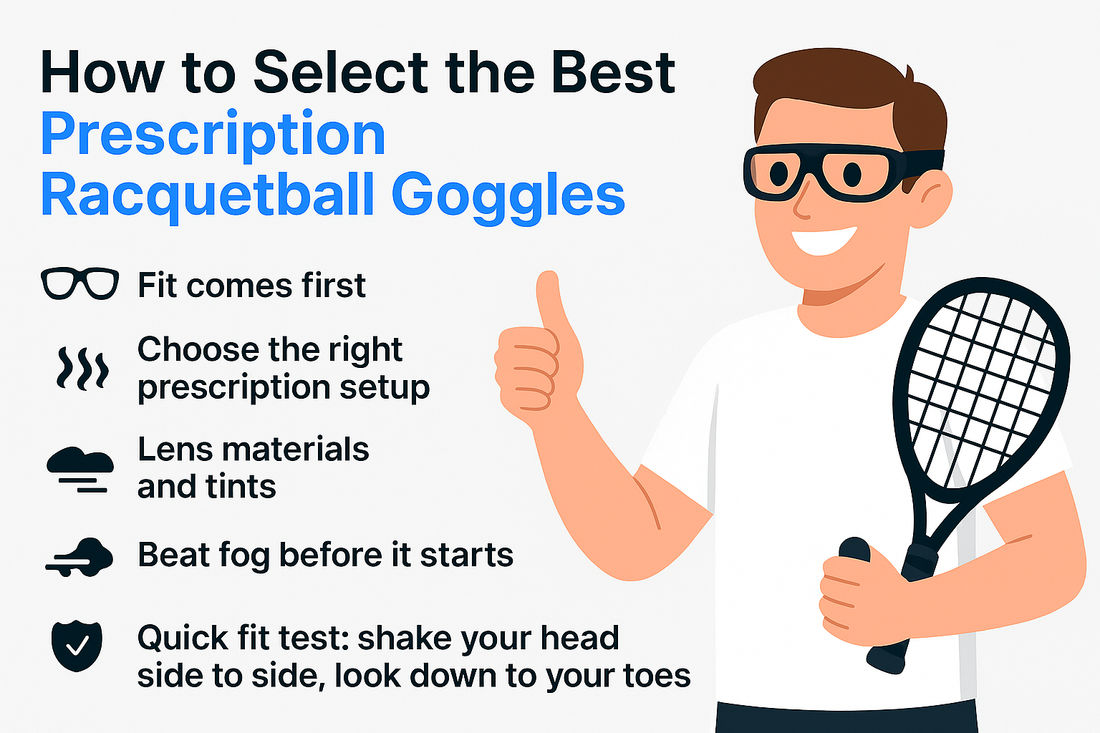
How to Select the Best Prescription Racquetball Goggles
Fast rallies, tight walls, and a zippy ball mean your eyes need serious protection and crystal-clear vision. If you wear prescription lenses, the right racquetball goggles help you see the ball earlier, react faster, and play with confidence. Here is a practical guide to choosing a pair that fits well, stays fog-free, and sharpens your focus on every shot. 👓🏃♂️
Fit Comes First
Comfort and stability are non-negotiable in a fast indoor game. Your goggles should feel secure without pinching, and they should stay put through lunges and quick turns.
- Frame size: The eye opening should fully cover your orbital area, with no gaps around the edges.
- Nose bridge and padding: Look for soft, grippy pads that prevent slipping and hot spots.
- Strap: Choose a wide, adjustable strap that distributes pressure and holds the frame centered.
- Helmet compatibility: If you wear a headband, sweatband, or cap, make sure the strap adjusts comfortably over it.
Quick fit test: shake your head side to side, look down to your toes, then do a few split steps. If the frame doesn’t bounce or slide, you are close to the right fit. 🛡️
Choose the Right Prescription Setup
You have two main pathways for prescriptions: direct lenses or an internal insert.
- Direct-Rx lenses: Your prescription is cut directly into the goggle lenses for a clean, lightweight feel and wide field of view.
- Rx insert: A small prescription insert sits behind a shield lens. It is easy to swap shields and can be cost-effective if your prescription changes.
Ask for wrap compensation if you pick a curved sport frame. This fine-tunes the optics so peripheral vision stays sharp. Share your pupillary distance and, if you use progressives, your segment height. Many players prefer single-vision distance lenses for maximal clarity on fast-moving shots, while others like sport-progressives with a larger distance zone.
Lens Materials and Tints
Impact resistance and optical clarity lead the list for racquetball.
- Material: Polycarbonate and Trivex are top choices. They are light, tough, and offer built-in UV protection.
- Coatings: Anti-scratch extends lens life, hydrophobic layers help sweat roll off, and anti-reflective reduces distracting glare from bright court lights.
- Tints: Clear is the standard for indoor courts. For dim courts, a light yellow or amber can enhance contrast. If you cross-train outdoors, consider gray or brown, or try photochromic lenses that adapt to light.
Beat Fog Before It Starts
Fog is the enemy of quick reactions. Combine smart design with simple habits for consistent clarity.
- Ventilation: Look for frames with vent channels that let warm air escape without exposing your eyes.
- Anti-fog treatment: Factory-applied coatings help, and an occasional anti-fog wipe can boost performance. Avoid touching the inner lens when damp.
- Sweat management: Use a moisture-wicking headband and keep a microfiber cloth in your bag for quick dabs between rallies. 💨
Protection That Keeps Up With Play
Racquetball demands full-coverage frames and shatter-resistant lenses. Choose a full-rim design that shields the orbital bone, plus a snug strap to prevent the frame from shifting on impact. Rounded edges and soft interior padding reduce pressure points and help absorb minor shocks.
Comfort Details You Will Notice
Small upgrades make a big difference during long matches:
- Flexible temples and a soft nose bridge to reduce red marks.
- Lightweight frame materials for less fatigue during extended play.
- Wide, unobstructed side vision so you pick up the ball early. 🎯
Care Tips for Longer Life
- Rinse off sweat and dust under cool water, then blot dry with microfiber.
- Store in a hard case to protect the lenses and strap elasticity.
- Avoid alcohol-based cleaners that can shorten the life of anti-fog and AR coatings.
Quick Court-Ready Checklist
- Secure, no-slip fit with a comfortable strap
- Polycarbonate or Trivex lenses with anti-scratch and anti-reflective
- Ventilation plus anti-fog plan (coating and cloth)
- Direct-Rx or insert that matches your prescription needs
- Clear tint for indoor courts, with options for cross-training
Looking for the right eyewear? Here are our top picks based on today’s article:
Based on today’s topic, here are a few of our top picks you might love:
- Bruno Sports Glasses in Black and Blue
- Tory Sports Glasses in White and Pink
- Steph Sports Glasses in Black and Blue
FAQs
How do I choose the right size for racquetball goggles?
Start with your usual eyeglass width, then test stability with a snug strap. The frame should fully cover your eye area without gaps or pressure spots.
What lens material is best for racquetball?
Polycarbonate or Trivex offers the best mix of impact resistance, light weight, and optical clarity for indoor play.
Can I get progressive lenses in racquetball goggles?
Yes. Many players use sport-progressives, but single-vision distance lenses often give the widest, clearest view of the ball.
Do anti-fog coatings really work?
They help, especially with good ventilation. Pair factory coatings with anti-fog wipes and a sweatband for the best results.
Why is the strap so important on sports eyewear?
A wide, adjustable strap keeps the frame stable during quick movements, which maintains clear vision and consistent protection.



